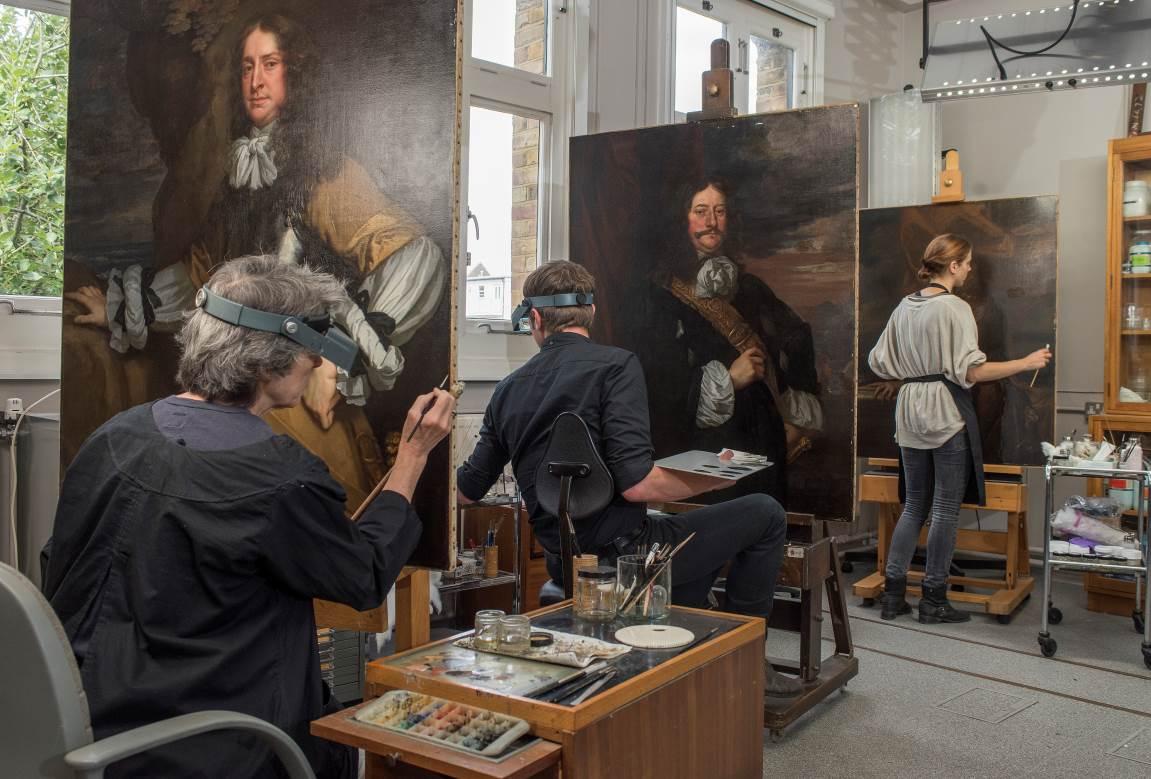05 Feb 2016
Thirty-three years after she first prepared Lely's Flagmen of Lowestoft for display, Senior Paintings Conservator Elizabeth Hamilton-Eddy prepares them for the Queen's House.
Back in 1983, I prepared the Lely paintings of the Flagmen of Lowestoft for immediate display in the Queen’s House and had the opportunity to carry out some minor conservation treatment on the full set. At that time, I noted in the conservation reports that they should undergo varnish removal; little anticipating that it would be another thirty-three years before I would have the opportunity to carry out my recommendations. It has been a wonderful experience working on these paintings with my colleagues to complete them in readiness for the Queen’s House reopening in July 2016.


The Flagmen of Lowestoft
In 1666 Sir Peter Lely (1618–80) painted portraits of the admirals and principal captains who had served under James, Duke of York, at the Battle of Lowestoft in June 1665.
All but three were well under way when Samuel Pepys visited Lely’s London studio in Covent Garden on 18 August 1666 and noted in his diary: ‘I to Mr. Lilly's [sic], the painter; and there saw the heads, some finished and all begun, of the Flagmen in the late great fight with the Duke of Yorke against the Dutch. The Duke of Yorke hath them done to hang in his chamber, and very finely they are done indeed.'
George IV presented eleven of the original paintings, plus a copy of one, as part of his foundation gift to the new Naval Gallery in the Painted Hall at Greenwich Hospital in 1824. They were transferred to the care of the National Maritime Museum when the Naval Gallery closed in 1936.

Condition and treatment
As part of the preparations for our rehang of the Queen’s House in 2016, it was decided that six of the Flagmen set should have full varnish removal and conservation: the portraits of Sir William Berkeley, Sir Thomas Teddeman, Sir Jeremiah Smith, Sir Christopher Myngs, Sir Joseph Jordan and Sir William Penn. As the paintings will be hanging in the King’s Presence Chamber, one of the most important spaces in the House which is receiving significant restoration, we decided that both the paintings and their frames should also look their best in the newly decorated space.
When I first worked on the set in 1983, the opportunity was taken to carry out some technical analysis, including X-radiographs showing the handling of the paint in the faces. During the current treatment we are looking carefully at the x-rays and the pictures themselves to try to understand Lely’s method of painting. Pepys’ account seems to suggest that the painting of the faces was done independently of the rest of the compositions, perhaps taken directly from the sitter, with aspects of costume and background added later. This was a traditional method to manage the workload for a busy portrait studio of the 17th century.


As mentioned above, the paintings all had a discoloured varnish, probably applied in the last century which obscured the original colours and brush work. Some areas such as the sky were damaged and heavily overpainted by a nineteenth or early twentieth century restorer. This repaint was thick, discoloured and concealed some original paint. Generally the treatments to the six identified for full varnish removal all had similar issues.
The discoloured varnish and overpaint were removed with a selection of solvents or solvent gels. Before we started cleaning, we carried out tiny cleaning tests at the edges of the painting, starting with the weakest solvents in dilute mixes, until the best one was identified as a suitable solution.


After removal of the discoloured varnish and the later repaint, we applied a synthetic retouching varnish with a brush, as a base for retouching. The retouching varnish also saturates the original paint layer enabling an accurate colour match and acts as a protective barrier from our retouching. We used pigments in a synthetic resin for the retouching.


The synthetic resin and retouching are easily removable again in future. When the retouching is complete, the painting is finally spray varnished with a synthetic resin.
The frames have also received conservation treatment; lost carving has been replaced and the gilded surface has been cleaned and retouched. All the pictures will have protective low-reflect glass.

Visit the Queen's House for free, or delve deeper into the topics with our new events programme.